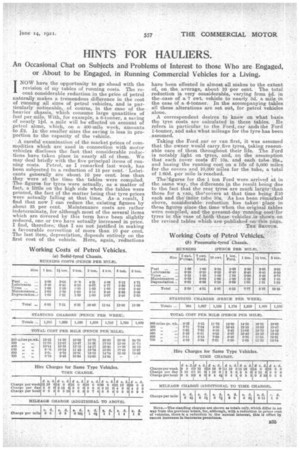HINTS FOR HAULIERS.
Page 35

If you've noticed an error in this article please click here to report it so we can fix it.
An Occasional Chat on Subjects and Problems of Interest to those Who are Engaged, or About to be Engaged, in Running Commercial Vehicles for a Living.
INOW have the opportunity to go ahead with the revision of my tables of running costs. The recent considerable reduction in the price of petrol naturally makes a tremendous difference in the cost of running all sizes of petrol vehicles, and is particularly noticeable, of course, in the case of the heavier chassis, which consume large quantities of fuel per mile. With, for example, a 6-tonner, a saving of nearly lid. a mile will be effected on account of petrol alone, which, on a 400-mile week, amounts to 22. In the smaller sizes the saving is less in proportion to the capacity of the vehicle.
A careful examination of the market prices of cornmodifies which are used in connection with motor vehicles discloses the fact that considerable reductions have taken place in nearly all of them. We may deal briefly with the five principal items of running costs. Petrol, as I remarked last. week, has been subjected to, a reduction of 15 per cent. Lubricants generally are about 10 per cent. less than they were at the time the tables were compiled. The figures for tyres were actually, as a matter of fact, a little on the high side when the tables were printed, the fact of the matter being that tyre prices were actually falling at that time. As. a result, I find that now I can reduce the, existing figures by about 25 per cent. Maintenance costs are rather indeterminate, for although most of the several items which are covered by this term have been slightly reduced, one or two have actually increased in price. I find, therefore,that I am not justified in making a favourable correction Of more than 10 per cent. The last item, depreciation, depends entirely on the first cost of the vehicle. Here, again, reductions have been effected in almost all makes to the extent of, on the average, about 10 per cent. The total reduction is very considerable, varying from id. in the ,case of a '7 cwt. vehicle to nearly 3d. a mile in the case of a 6-tonner. In the accompanying tables all these alterations are set out, for petrol vehicles alone.
A correspondent desires to know on what basis the tyre costs are calculated in these tables. He refers. in particular to the Ford, car and the Ford 1-tonner, and asks what mileage for the tyre has been assumed.
Taking the Ford car or van first, it was assumed that the owner would carry.five tyres, taking reasonable care of them throughout their life. The Ford is notably light on tyres, and, on the assumption that each cover costs 27 10s. and each tube -25s., and basing the running cost on a life of 5,000 miles for the covers and 10,000 miles for the tube, a total of 1.60d. per mile is reached.
Thefigures for the 1 ton Ford were arrived at in the same way, the difference in the result being due to the( fact that the rear tyres are much larger.than those for a van, the000Vers at that time being 210 each and theirnier tube 305. As has been remarked above, considerable reduction has taken place in these figures since-the time when the original tables were compiled, and,the present-day 'running cosVfor tyres in the case of both these vehicles is shown on the revised tables which are published -on this page.
TEE SKOTCH.






































